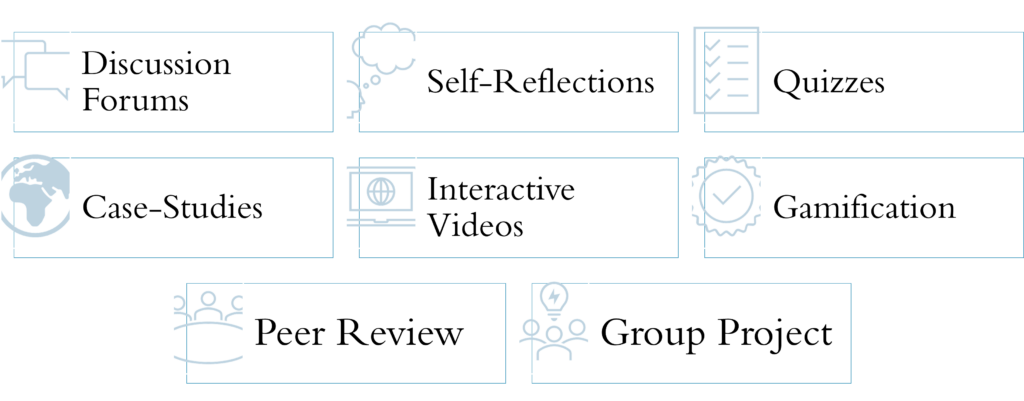
Incorporating Interactive Learning in Asynchronous Courses
Interactivity is a key consideration when developing an asynchronous course. Incorporating interactive tools and activities helps foster students’ active engagement and reduces the risk of passive learning. Interactivity refers to students’ ability to actively engage with course materials through tools, collaborative assignments, and dynamic activities. Rather than passively consuming information, students are invited to participate, respond, and engage with the content in meaningful ways. This approach makes the learning process more dynamic, engaging, and learner-centered.
As you develop active learning opportunities for your lessons, it’s essential to consider the self-directed nature of asynchronous learners. Activities should be designed to support students, ensuring they feel confident and independent as they navigate interactive elements. When well-planned, these activities can unlock opportunities for connection and foster a sense of community among online learners.
Interactivity in asynchronous courses can take many forms, including independent tasks or collaborative learning opportunities. A few examples of these interactive strategies are shown in the figure below.

Interactivity in Practice
Let’s look at some examples of interactivity that you can include in your asynchronous lessons.
Podcast Reflection
Ask students to listen to a podcast related to the course topic and reflect on three key takeaways. Provide a reflection box where students can share their thoughts, encouraging them to connect the podcast content to their learning.
Tip! Use the eConestoga Instructor Tool – Reflection Tool to add a Reflection page to your course shell.
Lesson Application with Padlet
After completing a weekly lesson topic, prompt students to consider how the concepts they’ve just learned can be applied to real-world scenarios. Have them create a visual representation of this connection (e.g., an image, icon) and upload it to a class Padlet board embedded in the LMS. This creates a shared space for students to explore diverse perspectives.
Tip! Check out the Teaching & Learning resource on Padlet to learn how to create a Padlet.
Collaborative Case-Study
Facilitate a collaborative learning opportunity by assigning students to small groups. Provide them with a case study and a set of guiding questions. Students can work together to analyze the case, answer the questions, and submit their shared responses to an Assignment folder for grading.
Utilizing Co-Pilot for Inspiration on Interactivity
Generative AI tools, such as Microsoft Co-Pilot, can provide helpful suggestions for creating engagement and incorporating interaction in your asynchronous lesson. Explore the following steps to translate existing synchronous instructional approaches to the asynchronous learning environment.
Step 1: Reflect on an active learning activity that resonated well with your learners and strongly aligned with your outcomes.
Step 2: Open Microsoft Co-Pilot and use the following prompts in order:
- Prompt 1: Provide suggestions on translating the learning activity {insert learning activity} to the asynchronous online learning environment.
- Prompt 2: What are some considerations for self-directed learning when implementing this activity?
Try out this tool for inspiration for active learning activities and how to implement them in your asynchronous course development.
Tip! Be sure to include feedback as part of your interactive design. Feedback will contribute to engagement, provide guidance for improvement and allow learners to adjust their learning strategies.
Interactivity enhances student engagement, fosters a sense of community in asynchronous learning environments, and improves knowledge retention. By intentionally incorporating interactive elements, you can create a dynamic and diverse learning experience that aligns with learning outcomes and connects to real-world applications.




